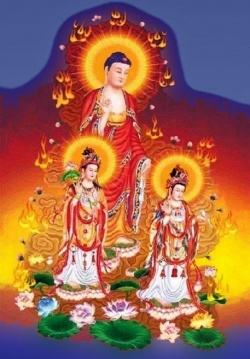Sautrantika
Sautrantika (Skt. Sautrāntika; Tib. མདོ་སྡེ་པ་ Dodépa; Wyl. mdo sde pa) means ‘Follower of the Sutras’, and the members of this school are so-called because they do not accept the Abhidharma as a definitive teaching of the Buddha.
According to Tibetan traditions, one of the two major Hinayana philosophical schools. Ontologically, Sautrantikas subscribe to a doctrine of radical momentariness and accept some dharmas as real and others as conceptual; epistemologically, they assert a representational realism. Vasubandhu’s Autocommentary on the Treasury of Higher Knowledge reflects Sautrantika views, as do some of the writings of Dignaga and Dharmakirti.
Sautrāntika, ancient school of Buddhism that emerged in India about the 2nd century bc as an offshoot of the Sarvāstivāda (“All-Is-Real Doctrine”). The school is so called because of its reliance on the sutras, or words of the Buddha, and its rejection of the authority of the Abhidharma, a part of the canon.
The Sautrāntikas maintained that though events (dharmas) have only momentary existence, there is a transmigrating substratum of consciousness that contains within it seeds of goodness that are in every person. The Sautrāntika sometimes is characterized as a transitional school that led to the development of the Mahāyāna tradition, and many of its views influenced later Yogācāra thought.
The higher of the two schools of Hinayana tenets. This school accepts both self cognizers and external objects to be truly existent. See Meaningful to Behold and Ocean of Nectar.
The Sautrāntika were an early school of Buddhist philosophy, generally believed to be descended from the Sthaviravada by way of their immediate parent school, the Sarvāstivādins. Their name means literally "those who rely upon the sutras", and indicated their rejection of the Abhidharma texts of other early Buddhist schools.
The Sarvāstivādins sometimes referred to them as the Dārṣṭāntika school, meaning "those who utilize the method of examples". This latter name may have been a pejorative label. Charles Willemen identifies the Sautrāntika as a Western branch of the Sarvāstivādins, active in the Gandhara area, who split from the Sarvāstivādins sometime before 200 CE, when the Sautrāntika name emerged.
According to the Abhidharmakośa of Vasubandhu, the Sautrāntika held the view that there may be many buddhas simultaneously, otherwise known as the doctrine of contemporaneous buddhas.
They used the concept of an āśraya (substrate, refuge) to explain the continuity of consciousness through rebirth, whereas the Pudgalavādins and the Vātsiputrīya school posited a pudgala (a 'personal entity' distinct from the five skandha), and where non-Buddhist Indian philosophy typically referred to an ātman.
The Sautrântika School points to a persisting very subtle consciousness (not an entire "person"), in which the remaining four aggregates are absorbed at the time of death. This influenced the Mahâyâna Yogâchâra or Mind-Only School (cf. the "âlaya-vijñâna" or storehouse consciousness) as well as the "bardo" teachings.
Subschools
There are two kinds of Sautrantikas or ‘Sutra Followers’:
the Sautrantikas Following Scripture whose description of the two truths accords with that of the Vaibhashikas; and
the Sautrantikas Following Logic who take as their basis Dharmakirti’s Seven Treatises on Logic.
Sautrantika View of Two Truths
Khenpo Ngakchung says:
Then, if we consider the Sautrantikas, it says in the Commentary on Valid Cognition[1]:
"That which can perform a function
Is here said to be ultimately existent.
All that can not perform a function
Is said to be relatively existent.
These are specific and general characteristics."
So, here, in this context, anything with unique characteristics that can perform a function is said to be absolute truth, and anything that is generally characterized and can not perform a function is said to belong merely to relative truth. Although things are explained this way when analyzing things so as to determine whether or not they have unique characteristics, this does not mean to say that there are not other classifications of the two truths.
Other Tenets
They believe that the present sense-consciousness arises based on the coming together of the object, faculty and consciousness in the previous moment.
They believe that non-concurrent formations and unconditioned phenomena are not substantially existent, but merely imputations.
The characteristics of arising, dwelling and ceasing are not distinct from entities, but are distinguished from them conceptually.
Objects are hidden, since only the mental features or aspects (Tib. རྣམ་པ་, Wyl. rnam pa) are perceived.
Alternative Translations
Sutra Followers
References
དོན་དམ་དོན་བྱེད་ནུས་པ་གང༌། །
དེ་འདིར་དོན་དམ་ཡོད་པ་ཡིན། །
གཞན་ནི་ཀུན་རྫོབ་ཡོད་པ་སྟེ། །
That which can ultimately perform a function
Is here said to be ultimately existent.
All else besides has relative existence.
Dharmakīrti, Commentary on Valid Cognition, chapter III, 3
Sautrantika (mdo sde pa). A Hinayana school of philosophy and the second of the Four Major Buddhist Schools known for its reliance on the sutras rather than Abhidharma.
Traditionist [RY]
Sautrantika/ follower of the sutras [RB]
Sutra Follower [thd]
Sautrantikas, Traditionists, a hinayana school of philosophy and the 2nd of the 4 major Buddhist Schools know for its reliance on the sutras rather than Abhidharma [JV]
Sautrantika school, Sautrantika, "sutra-follower / adherent," [a Hinayana school of philosophy, grub mtha' bzhi. "sutra-Adherent". Sautrantika/ follower of the sutras; def: 'di ni sgo drug pa dang 'phags pa bzang po spyod pa la sogs pa'i mdo sde rnams sgra ji bzhin par khas len cing mdo sde de dag gi rjes su 'brang bas mdo sde pa ste/ ming gzhan dpes ston pa la mkhas pas dpes ston pa [RY]
Sutra Follower rdul - particle, materiality [RY]
see also: Sautrāntika



